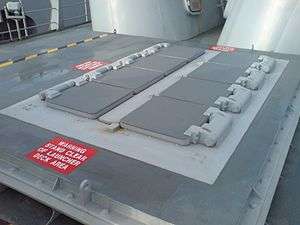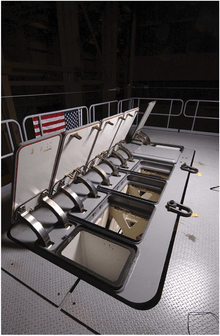Mark 41 Vertical Launching System
The Mark 41 Vertical Launching System (Mk 41 VLS) is a shipborne missile canister launching system which provides a rapid-fire launch capability against hostile threats.[1] The Vertical Launch System (VLS) concept was derived from work on the Aegis Combat System.[2]
| Mk 41 Vertical Launching System | |
|---|---|
 A single 8-cell Mk 41 VLS module fitted to New Zealand frigate HMNZS Te Kaha | |
| Type | Missile Launching System |
| Place of origin | United States |
| Service history | |
| In service | 1986 – present |
| Used by | United States Navy and a number of others |
| Wars | Cold War Tanker War Gulf War Kosovo War War on Terror |
| Production history | |
| Designed | 1970s |
| Manufacturer | Martin Marietta Lockheed Martin |
| Variants | Mk 57 |
History
Refinement of the initial concept of Aegis system in the 1960s continued through the 1960s and 1970s, and the Mk 41 was conceived in 1976.[2] Originally, the system was only intended to fire the RIM-66 Standard missile, but the height of the Mk 41 was increased to accommodate the larger Tomahawk missile.[2] The prototype for the launcher was tested and evaluated on board USS Norton Sound (AVM-1). The first operational launcher was installed aboard USS Bunker Hill.[2]
Specifications
Mark 41 (Mk 41)
The Mk 41 is capable of firing the following missiles: RIM-66 Standard, RIM-67 Standard, RIM-161 Standard Missile 3, RIM-174 Standard ERAM, RGM-109 Tomahawk, RUM-139 VL-ASROC anti-submarine missile, RIM-7 Sea Sparrow anti-air missile, and RIM-162 ESSM.[2] The missiles are pre-loaded into "canisters", which are then loaded into the individual "cells" of the launcher. The ESSM is loaded in a quad-pack with 4 missiles in one Mk 25 canister, older types of 8 cell modules are not able to use ESSM.[2][3] Launcher cells are fitted to ships in 8 cell modules (2 rows of 4) that share a common uptake hatch (exhaust system) sited between the two rows.[2] The Mk 41 VLS adopts modular design concept, which result in different versions that vary in size and weight due to different "canisters" in various modules. The height (determining missile length) of the launcher comes in three sizes: 209 inches (5.3 m) for the self-defense version, 266 in (6.8 m) for the tactical version, and 303 inches (7.7 m) for the strike version. The empty weight for an 8-cell module is 26,800 pounds (12.2 t) for the self-defense version, 29,800 pounds (13.5 t) for the tactical version, and 32,000 pounds (15 t) for the strike version.[2] Ticonderoga cruisers and Arleigh Burke destroyers up to DDG-78 have a Strikedown module fore and aft, which consists of five cells and a collapsible crane for assisting with replenishment at sea. As replenishment of large missiles at sea was later seen as impractical and dangerous, Strikedown modules fell out of use on newer ships.[2]
Mark 57 (Mk 57)

The Mk 57 VLS is an evolution of Mk 41 VLS. Unlike the Mk 41, the Mk 57 is designed to be installed on the ship periphery instead of in centralized magazines. Developed by Raytheon, it provides backwards compatibility with existing missiles while allowing new missiles with significantly increased propulsion and payloads. While allowing for slightly larger missiles than the Mk 41, the primary improvement of Mk 57 is its exhaust gas management system that can accommodate new missile designs having up to 45 percent greater rocket motor mass flow rate than that of Mk 41.[4] The unique symmetric geometry of the U-shaped gas management system facilitates the egress of gases, while minimizing flow into witness cells and reversed flow into the active cell. Another advantage is the elimination of the water deluge system, which is used to cool the missile canister in the event that the missile restraint bolts do not release after rocket motor ignition. Elimination of the water deluge system significantly reduces maintenance and personnel requirements, and protects against accidental missile wet-down.
| Missiles | 4 cells of 2 |
|---|---|
| Width | 7.25 ft (2.21 m) |
| Length | 14.2 ft (4.3 m) |
| Height | 26 ft (7.9 m) |
| Weight | 33,600 lb (15,200 kg) |
| Maximum canister width | 28 in (0.71 m) |
| Maximum canister length | 283 in (7.2 m) |
| Maximum canistered weight | 9,020 lb (4,090 kg) |
Variants
_Mark_41_Vertical_Launching_System.jpg)
- MK 41 Mod 0, Ticonderoga-class cruisers, two 61 cell Vertical Launcher Mk 158 Mod 0 or Mod 1, forward and aft.[3]
- MK 41 Mod 1, Spruance-class destroyers, 61 cells forward.[3]
- MK 41 Mod 2, Arleigh Burke-class destroyers, DDG-51 to DDG-78, one 29 cell Vertical Launcher Mk 159 Mod 0 forward, one 61 cell Vertical Launcher Mk 158 Mod 0 aft.[3]
- MK 41 Mod 3, Brandenburg-class frigates (Germany), 16 cells.
- MK 41 Mod 5, Anzac-class frigates (Australia, New Zealand), 8 cells
- MK 41 Mod 7, Arleigh Burke-class destroyer, DDG-79 to DDG-91, one 32 cell Vertical Launcher Mk 177 Mod 0 forward, one 64 cell Vertical Launcher Mk 176 Mod 0 aft.[3][6]
- MK 41 Mod 8, Barbaros-class frigates (Turkey), second pair of ships
- MK 41 Mod 9, De Zeven Provinciën-class frigate (Netherlands), 40 cells
- MK 41 Mod 10, Sachsen-class frigates (Germany), 32 cells
- MK 41 Mod 15, Arleigh Burke-class destroyer, DDG-92 and up, one 32 cell Vertical Launcher Mk 177 Mod 3 forward, one 64 cell Vertical Launcher Mk 176 Mod 2 aft.[3][6]
- MK 41 Mod 16, Adelaide-class frigate (Australia), 8 cells
Operators
_during_a_training_exercise.jpg)
- Anzac-class frigate - (8 cells)
- Hobart-class destroyer - (48 cells)
- Hunter-class frigate - (Unspecified although model from Pacific 2019 shows 32 cells)[7]
- Iroquois-class destroyer - (29 cells) (Retired)
- Canadian Surface Combatant - (Unspecified)
- Adelaide-class frigate - (8 cells)
- Iver Huitfeldt-class frigate - (32 cells)
- Pohjanmaa-class corvette - (8 cells)
- Sachsen-class frigate - (32 cells)
- Brandenburg-class frigate - (16 cells)
- Atago-class destroyer - (96 cells)
- Kongō-class destroyer - (90 cells)
- Hyūga-class helicopter destroyer - (16 cells)
- Murasame-class destroyer - (32 cells)
- Takanami-class destroyer - (32 cells)
- Akizuki-class destroyer - (32 cells)
- Asahi-class destroyer - (32 cells)
- De Zeven Provinciën-class frigate - (40 cells)
- Fridtjof Nansen-class frigate - (8 or 16 cells)
- Anzac-class frigate - (8 cells)
- Chungmugong Yi Sun-shin-class destroyer (KDX-II) - (32 cells)
- King Sejong the Great-class destroyer (KDX-III) - (80 cells)
- Álvaro de Bazán-class frigate - (48 cells)
- Kaohsiung-class tank landing ship - (Test Ship)[8]
- Naresuan-class frigate - (8 cells)
- Bhumibol Adulyadej-class frigate - (8 cells)
- G class frigate - (8 cells)
- Barbaros-class frigate - (16 cells)
- Type 26 frigate- (24 cells)
- Spruance-class destroyer - (61 cells, installed on 24 of 31 vessels) (Retired)
- Arleigh Burke-class destroyer - (90 or 96 cells)
- Ticonderoga-class cruiser - (122 cells)
- Zumwalt-class destroyer - (80 Mk 57 cells)
Gallery
_aboard_the_guided_missile_cruiser_USS_San_Jacinto_(CG_56).jpg) The VLS cells on board USS San Jacinto.
The VLS cells on board USS San Jacinto._stabilize_a_crate_containing_a_Tomahawk_cruise_missile.jpg) A Tomahawk missile canister being loaded into a VLS aboard the Arleigh Burke class destroyer USS Curtis Wilbur
A Tomahawk missile canister being loaded into a VLS aboard the Arleigh Burke class destroyer USS Curtis Wilbur_inspect_the_MK_41_Vertical_Launching_System_(VLS)_for_water_to_prevent_electrical_failure.jpg) VLS cells open for inspection aboard USS Fitzgerald
VLS cells open for inspection aboard USS Fitzgerald%2C_designed_to_intercept_short_to_medium-ranged_ballistic_missile_threats%2C_is_launched_from_the_Pearl_Harbor-based_Aegis_cruiser_USS_Lake_Erie_(CG_70).jpg) An SM3 departs the Mk 41 VLS aboard USS Lake Erie with uptake hatch and cell hatch open.
An SM3 departs the Mk 41 VLS aboard USS Lake Erie with uptake hatch and cell hatch open. VLS Strikedown crane folded, aboard USS Mitscher
VLS Strikedown crane folded, aboard USS Mitscher VLS Strikedown crane extended, aboard USS Hopper
VLS Strikedown crane extended, aboard USS Hopper Diagram of a Mk 41 Mod 0 VLS.
Diagram of a Mk 41 Mod 0 VLS.
See also
- French Sylver
- Chinese GJB 5860-2006
- Russian Redut
References
- "Mark 41 Vertical Launching System". Retrieved 21 September 2011.
- Friedman, Norman (2006). The Naval Institute Guide to World Naval Weapon Systems (5th ed.). Annapolis, MD: Naval Institute Press. p. 600.
- NAVEDTRA 14324, Gunner's Mate, Chapter 7.
- Mk 57
- "MK 57 Vertical Launching System Zumwalt Class Destroyer Program" (PDF).
- U.S. Navy Guided Missile Launcher Systems Accessed May 15, 2014.
- Gain, Nathan (2019-10-11). "PACIFIC 2019: SEA 5000 Hunter-class frigates to benefit from Aegis CMS". Naval News. Retrieved 2019-10-31.
- Everington, Keoni. "Mysterious radar ship spotted off coast of S. Taiwan". www.taiwannews.com.tw. Taiwan News. Retrieved 15 April 2020.
External links
| Wikimedia Commons has media related to Mark 41 Vertical Launching System. |